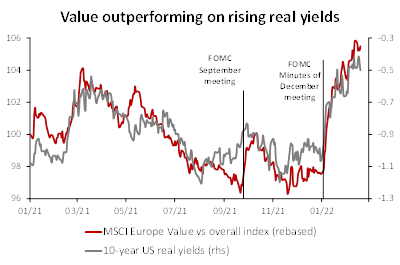Because the crisis in Ukraine is harming economies and financial markets

The crisis in Ukraine accentuates volatility and downside risk for the economy and financial markets. The analysis by Filippo Casagrande, head of insurance investment solutions at Generali Asset & Wealth Management
In recent days we have seen an escalation of tensions surrounding the Ukrainian crisis. On February 21, Russian President Putin recognized the breakaway republics of Donbass , sending military contingents to the disputed regions with Kiev. The scenario recalls what happened in Georgia in the summer of 2008, when Russia intervened in support of the separatists of the regions of South Ossetia and Abkhazia; on that occasion, the Georgian government responded militarily, but was quickly defeated by Russian forces, with the consequent recognition of the two separatist republics by Russia.
The current situation is undoubtedly more complex, given the size and strategic role played by Ukraine for the West. The United States and the United Kingdom are pushing for heavy sanctions against Russia, while the response of the European Union is more uncertain. Economic sanctions would hit energy supply at a time of already severe oil and gas price tensions and, while diplomacies remain at work, it is undeniable that tensions over Ukraine represent a further element of volatility and downside risk for the economy and financial markets.
It should be noted, however, that the financial markets have already been in a situation of tension and increased volatility for weeks. This is due to the strong repricing of expectations on the course of monetary policies by the main central banks, on all the Fed and the ECB. Inflation has, in fact, continued to surprise on the upside due to a combination of rising energy prices, problems in supply chains, but also and increasingly due to the increase in wage pressures linked to the sharp decline in unemployment. practically returned to pre-Covid levels in the United States.
The rush of inflation, combined with less expansive monetary policies and geopolitical tensions are inevitably weighing on growth estimates, which however remain – and it should be remembered – well above potential levels. In the United States, the consensus now sees 3.7% growth over the course of 2022, while the Eurozone estimates have been revised from 4.4% to 4.0%, mainly due to the slowdown in Germany (from 4 , 5% to 3.7%). The Bundesbank recently stated that the German economy could also contract in the first quarter of 2022, which would lead to a technical recession, given the decline in GDP recorded in the last quarter of 2021. Instead, inflation estimates continue to rise for this year, it reached 5.0% in the United States (compared to + 3.0% in September, when the Fed started talking about tapering) and 3.7% in the Eurozone (from 1.5% in September ).
OUTLOOK FOR FINANCIAL MARKETS: COLD BLOOD AND A LOT OF SELECTIVITY
All major financial instruments had a very difficult start to the year, and losses also accumulated in February. Indeed, the rise in interest rates and the correction of share prices put the traditional balanced portfolio in difficulty, although there are always pockets of opportunities to exploit.
The world of fixed income has suffered heavy losses: the sharp rise in underlying rates (10-year Bund, Treasury and Gilt rates up by 45, 47 and 58 basis points where the German 10-year rate of return has risen well beyond the psychological threshold of 0% ), in fact, the widening of spreads has also been added, both in the public and private sectors.
Just think of the ten-year BTP-Bund spread, which reached the 170bps area, at its highest since June 2020 and the credit world also suffered where the European Investment Grade (IG) spread rose to 120bps (+22bps since the beginning). year), while High Yield (HY) recorded +57 bps to 388. Similar increases also in the United States, with generation of performance / capital losses between minus 3% and minus 5% for all major asset classes in the bond world.
The equity world has so far suffered less in risk-adjusted terms, but has nonetheless recorded significant declines, in some cases double-digit. The American market suffered the most (Nasdaq down 11.8%, S&P 500 down by -7.2%), but also in the Eurozone (MSCI EMU: -3.4%) and Japan (Topix: -1 , 5%). On the other hand, the British stock market (FTSE 100: + 3.8%, favored by the energy component) and the emerging lists (+ 0.8%), on the upside. However, the most significant phenomenon on the stock markets is sectoral and style rotation, which favored the Value sector (+ 5.3% in Europe since the beginning of the year) to the detriment of the Growth sector (-10.9%), where the Value was driven by the energy sector (+ 14.4%), financials and banks (+ 13.5%) in particular. Banks are benefiting in particular from the rise in real rates, which rose sharply with the shift in expectations on monetary policies.

Looking ahead to 2022, we reiterate the centrality of the normalization process of central banks, and above all of the Fed, for the evolution of financial markets. Growth, after a likely weak first quarter, is also expected to improve, also thanks to the lower impact linked to the Covid pandemic, with more and more countries removing all restrictions. Of course, the unknown factor remains on the Russia-Ukraine tensions, but it is important not to lose the underlying framework that remains dominated precisely by central banks.
This is a machine translation from Italian language of a post published on Start Magazine at the URL https://www.startmag.it/economia/perche-la-crisi-in-ucraina-attapira-economie-e-mercati-finanziari/ on Wed, 23 Feb 2022 06:32:54 +0000.
